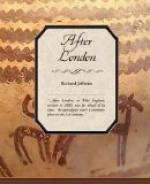The next kind is the white hog, which has much the same habits as the former, except that it is usually found in moist places, near lakes and rivers, and is often called the marsh-pig. The third kind is perfectly black, much smaller in size, and very active, affording by far the best sport, and also the best food when killed. As they are found on the hills where the ground is somewhat more open, horses can follow freely, and the chase becomes exciting. By some it is called the hill-hog, from the locality it frequents. The small tusks of the black boar are used for many ornamental purposes.
These three species are considered to be the descendants of the various domestic pigs of the ancients, but the fourth, or grey, is thought to be the true wild boar. It is seldom seen, but is most common in the south-western forests, where, from the quantity of fern, it is called the fern-pig. This kind is believed to represent the true wild boar, which was extinct, or merged in the domestic hog among the ancients, except in that neighbourhood where the strain remained.
With wild times, the wild habits have returned, and the grey boar is at once the most difficult of access, and the most ready to encounter either dogs or men. Although the first, or thorn-hog, does the most damage to the agriculturist because of its numbers, and its habit of haunting the neighbourhood of enclosures, the others are equally injurious if they chance to enter the cultivated fields.
The three principal kinds of wild sheep are the horned, the thyme, and the meadow. The thyme sheep are the smallest, and haunt the highest hills in the south, where, feeding on the sweet herbage of the ridges, their flesh is said to acquire a flavour of wild thyme. They move in small flocks of not more than thirty, and are the most difficult to approach, being far more wary than deer, so continuously are they hunted by the wood-dogs. The horned are larger, and move in greater numbers; as many as two hundred are sometimes seen together.
They are found on the lower slopes and plains, and in the woods. The meadow sheep have long shaggy wool, which is made into various articles of clothing, but they are not numerous. They haunt river sides, and the shores of lakes and ponds. None of these are easily got at, on account of the wood-dogs; but the rams of the horned kind are reputed to sometimes turn upon the pursuing pack, and butt them to death. In the extremity of their terror whole flocks of wild sheep have been driven over precipices and into quagmires and torrents.
Besides these, there are several other species whose haunt is local. On the islands, especially, different kinds are found. The wood-dogs will occasionally, in calm weather, swim out to an island and kill every sheep upon it.
From the horses that were in use among the ancients the two wild species now found are known to have descended, a fact confirmed by their evident resemblance to the horses we still retain. The largest wild horse is almost black, or inclined to a dark colour, somewhat less in size than our present waggon horses, but of the same heavy make. It is, however, much swifter, on account of having enjoyed liberty for so long. It is called the bush-horse, being generally distributed among thickets and meadow-like lands adjoining water.




